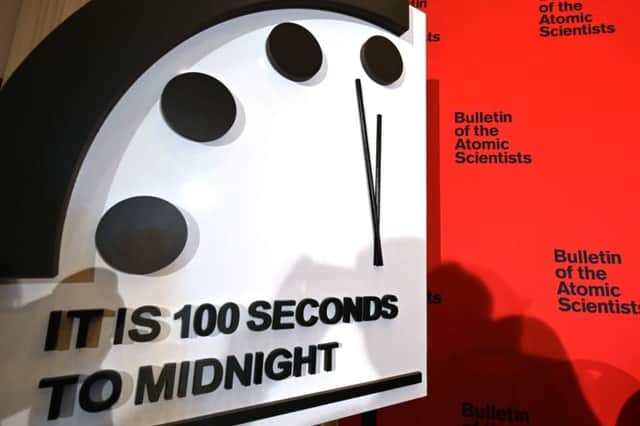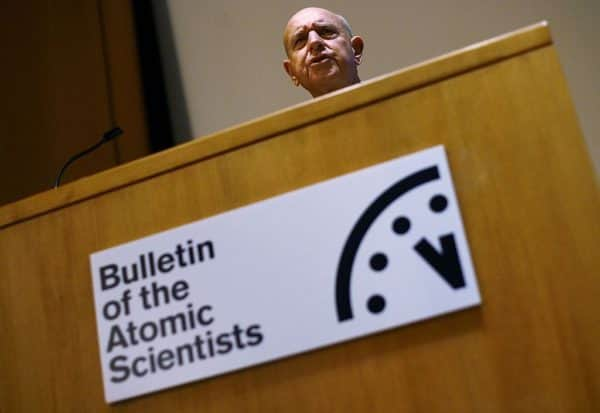The Doomsday Clock is at 100 seconds to midnight in 2021 - here's what it means


The “Doomsday Clock” has remained at 100 seconds, staying the closest to midnight it has ever been for the second year running.
Maintaining last year’s position means the clock’s keepers – an independent non-profit organisation run by some of the world’s most eminent scientists – believe the threat of global apocalypse has not cooled off in the past 12 months.
Advertisement
Hide AdAdvertisement
Hide AdRachel Bronson, president and chief executive of the Bulletin of the Atomic Scientists (BAS), cited the ongoing coronavirus pandemic as one of the reasons for this year’s count.
The pandemic revealed “just how unprepared and unwilling countries and the international system are to handle global emergencies properly,” she said.
Here is everything you need to know about it.
What is the Doomsday Clock?
The Doomsday Clock was established in 1947 by experts at the BAS, who were working on the Manhattan Project to design and build the first atomic bomb.
The metaphorical timepiece acts as a symbol for how close the BAS believes humanity is to a worldwide catastrophe, and was originally intended to warn of the threat of nuclear armageddon.
Advertisement
Hide AdAdvertisement
Hide Ad“By our estimation, the potential for the world to stumble into nuclear war – an ever-present danger over the last 75 years – increased in 2020,” said Bronson.
"Events like the deadly assault earlier this month on the US Capitol renewed legitimate concerns about national leaders who have sole control of the use of nuclear weapons.”
The Clock also takes into account the likelihood of emerging threats like climate change, advances in biotechnology and artificial intelligence.
Why is the clock closer than ever to midnight?


The Doomsday Clock started at seven minutes to midnight.
In 2020, it was moved forward by 20 seconds to be just 100 seconds away from striking 12, the closest to Doomsday it has ever been in its history.
Advertisement
Hide AdAdvertisement
Hide AdAccording to the BAS, that meant the world was entering into a sub-two-minute warning realm, “a period when danger is high and the margin for error low.”
Having now killed more than two million people across the world, the BAS say Covid-19 is an unmistakable “wake-up call” for world leaders.
“In this time of genuine crisis, governments around the world too often abdicated responsibility, ignored scientific advice, did not co-operate to communicate effectively and consequently failed to protect the health and welfare of their citizens,” said Bronson.
Scientists are also concerned about accelerating nuclear programmes in multiple countries, which they blamed for moving the world into “less stable and manageable territory” last year, as hypersonic glide vehicles, ballistic missile defences, and weapons-delivery systems were developed.
Are we doomed?
Advertisement
Hide AdAdvertisement
Hide AdScientists have some hope that tensions can be eased, with new US President Joe Biden’s intention to rejoin the Paris Agreement and stay in the World Health Organisation mentioned as positives.
"These developments have not yet yielded substantive progress toward a safer world… [and] are not sufficient to move the Clock away from midnight,” they said. “But they are positive.”
They also provided some tips on how humanity can avoid certain disaster in their statement.
"The US, Russia and the world’s nuclear powers must stop shouting at each other,” said the BAS’ executive chair and former California Governor, Jerry Brown. “It’s time to eliminate nuclear weapons, not build more of them.”
Advertisement
Hide AdAdvertisement
Hide AdEllen Johnson Sirleaf, a Nobel Peace Prize recipient and former President of Liberia, said; “It is only through collective action and responsible leadership that we can secure a peaceful and habitable planet for future generations.
"The new Presidency of Joe Biden has a chance to reassert US commitments to the values and institutions of multilateralism; there is no other way for humanity to overcome the dangers posed by pandemics, climate change and the risk of nuclear war.”
A version of this article originally appeared on our sister title, The Scotsman